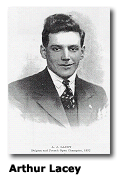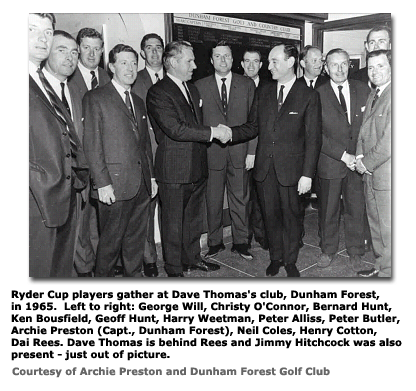|
| |
|
week - long off the tee and very impressive around the greens. He
had beaten two of golf’s great players in one day on his way to the
final - Henry Cotton and the Belgian Flory van Donck, who was to be
the first continental holder of the Vardon Trophy in 1953, the
season when he equalled von Nida’s record of seven wins. What an
asset he would have been to the Ryder Cup side, but the inclusion of
Continental Europeans was a long way off. Weetman was four under
fours when he beat the ‘Maestro’ Cotton 3&2. He was to be in five
finals from 1951 to 1960, winning two titles. Following his victory
he was duly selected for his first Ryder Cup and was to go on to
play in every match until 1963.
In 1951, at the Northumberland Golf Club, I first encountered Harry
Fernie’s 16-year-old Newcastle born Welsh assistant, Dave Thomas He
was the ‘white hope’ of the North-East; an impressive striker very
long off the tee and, in those days, sometimes a little wild, but he
soon harnessed his power to become one of the straightest long
drivers in the game. I wrote of his potential in my newspaper column
saying that he appeared to have everything it takes to get to the
top, but hoping that he would not be rushed. “It would be a
tragedy”, I said, “if his progress should be retarded by thrusting
him into the ‘hurly-burly’ of major tournament play, with its
tremendous mental strain, before he is quite ready”. His
circumstances caused him to plunge straight into tournament golf and
it was some years before he broke through, winning the British
Assistants and Belgian Open titles in 1955. The Captain of the PGA
in its Centenary Year, Thomas is now best known for his course
designs, particularly the Belfry designed in partnership with Peter
Alliss. In my article I said that Peter was another member of the
“younger school” who I expected to “come out tops”. He had just
returned from doing his National Service and I recalled that he had
shown great promise before joining the forces and should not take
long to re-establish himself in top line golf. A couple of years
later he became the youngest player to be selected for the Ryder Cup
and was to win 21 tournaments, including three in a row in 1958 -
the Italian, Spanish and Portuguese Opens. Like most touring pros,
he still had a club job and some members resented him neglecting his
duties. On his triumphant return one demanded to know where he had
been and added resentfully: “I’ve been waiting three weeks for a
lesson”. The name P. Alliss appears in the Ryder Cup and European Tour records over five decades and editors of record books sometimes get father and son confused; one shows Peter Alliss winning the News of the World Tournament in 1937, when he would have been only six years old! I played against Percy on a number of occasions and once |

 good with a win against Ed ‘Porky’ Oliver in the singles and,
with partner Charlie Ward, accounting for Oliver and Henry Ransom in
the foursomes. Charlie lost to Hogan 3&2 and Weetman lost to Lloyd
Mangrum by 6&5. Harry Weetman was to beat the great Sam Snead at
Wentworth in 1953 but despite his match play record he had little
success and his next win was ten years later in his last match.
Although he did not gain a point in the match the only other winner
at Pinehurst was captain Arthur Lacey. He met a woman there and
married her, eventually returning to live in the USA.
good with a win against Ed ‘Porky’ Oliver in the singles and,
with partner Charlie Ward, accounting for Oliver and Henry Ransom in
the foursomes. Charlie lost to Hogan 3&2 and Weetman lost to Lloyd
Mangrum by 6&5. Harry Weetman was to beat the great Sam Snead at
Wentworth in 1953 but despite his match play record he had little
success and his next win was ten years later in his last match.
Although he did not gain a point in the match the only other winner
at Pinehurst was captain Arthur Lacey. He met a woman there and
married her, eventually returning to live in the USA. Dave Thomas made his Ryder Cup debut a year after taking second
place in the 1958 Open - after a playoff with five-time winner Peter
Thomson. He was runner-up again in 1966 to Jack Nicklaus.
Dave Thomas made his Ryder Cup debut a year after taking second
place in the 1958 Open - after a playoff with five-time winner Peter
Thomson. He was runner-up again in 1966 to Jack Nicklaus.